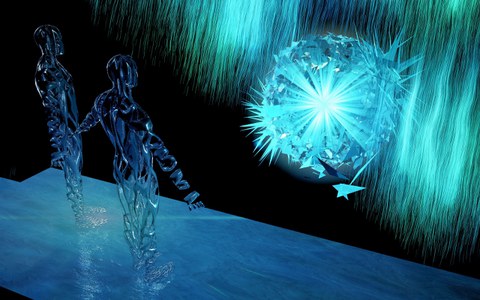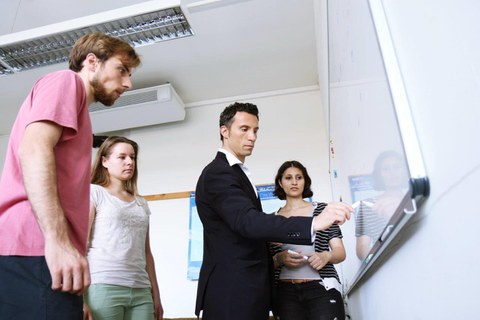Dec 08, 2017
‘Spying’ on the hidden geometry of complex networks through machine intelligence
An international team of scientists led by Dr. Carlo Vittorio Cannistraci, Junior Group Leader of the Biomedical Cybernetics lab at the BIOTEChnology Center TU Dresden, has developed ‘coalescent embedding’: a class of algorithms that leverage machine intelligence to retrieve the hidden geometrical rules that shape the structure of complex networks. From brain connectivity to social media, ‘coalescent embedding’ can have a future impact on disparate fields dealing with big-network-data including biology, medicine, physics and social science.
Archimedes envisioned that a network structure - a polygon made by triangles - created by sampling the geometrical law of a circle, is a useful device to approximate properties such as the area of the original circle. Nearly 2000 years later, a fascinating and challenging problem of network science is, conceptually, the inverse of Archimedes’ one and consists of mapping a network back to the original geometry. Dr. Cannistraci and colleagues have discovered that intelligent machines for unsupervised recognition and visualization of similarities in big-data can also contribute to offer a computational solution to this network geometry problem, in particular when the hidden geometry of the complex networks is hyperbolic.
With the beginning of the era of Big Data and the rise of network science, complex physical systems are studied more and more from a network perspective. In recent years, network geometry is an emerging branch, which supports the idea that real networks are discretizations of continuous geometrical spaces and these latent spaces shape their topological properties. In particular, the hyperbolic space has been shown to reproduce the most important structural features observed in real systems. An efficient method to uncover the latent hyperbolic geometry of the networks is now offered by ‘coalescent embedding’, an algorithm invented by Dr. Cannistraci that has been realized and tested by the Biomedical Cybernetics Group.
Coalescent embedding can be applied to any kind of networked physical system, since it only requires as an input the network topology, represented by the interacting parts of the system (nodes) and the connections between them (links). No field-specific information is needed. The algorithm exploits unsupervised machine learning techniques for dimensionality reduction in order to accurately infer the similarities between the nodes and it provides as an output the hyperbolic embedding of the network: every node is assigned to a geometrical location in the hyperbolic space, such that nodes that are geometrically closer are more likely to interact. With respect to previously developed methods, coalescent embedding significantly reduces the computational time, it can map networks to spaces of more than two dimensions and, when they are available, it can exploit additional information on the strength of the interactions.
Mapping of a network in the geometrical space allows one to perform several studies that might not be equally effective for the original topology. Examples of applications are the detection of communities in social networks, the prediction of protein-protein interactions in biological networks and the analysis of routing in Internet networks. In a recent neuroscience study led by Dr. Cannistraci, available as a preprint on the arXiv repository (Coalescent embedding in the hyperbolic space unsupervisedly discloses the hidden geometry of the brain), coalescent embedding was applied to structural MRI human brain connectomes leading to interesting discoveries, such as the detection of pathological changes in the connectomes of Parkinson’s disease patients. This finding provides a new perspective towards the realization of latent geometry network markers for the diagnosis of brain disorders and diseases.
“Experiments on many networks showed that our algorithm is able to provide, in just few minutes, more accurate embedding than that obtained by previous techniques that requires many days of computation, opening the way to the investigation also of large-scale systems”, explains Alessandro Muscoloni and Josephine Maria Thomas, the first authors of the study.
“While at the annual network science conference in Korea in 2016, I presented the first results and some of my colleagues hardly believed that unsupervised machine intelligence could offer an accurate computational solution to this fundamental network geometry problem. I hope that this article will inspire ‘unconventional’ solutions to problems relating to the physics of complex systems, where machine intelligence can represent a complementary tool to integrate with classical statistical mechanics“, says Carlo Vittorio Cannistraci, the corresponding author of the study.
This study was conducted in collaboration with Prof. Ginestra Bianconi from the School of Mathematical Sciences, Queen Mary University of London (UK) and with the participation of the Brain Bio-Inspired Computing (BBC) Lab, of the IRCCS Centro Neurolesi “Bonino Pulejo”, Messina, Italy. Funding was provided by: the Independent Group Leader Starting Grant of the Technische Universität Dresden (TUD); Klaus Tschira Stiftung (KTS) gGmbH, Germany (Grant number: 00.285.2016); research pool (Forschungspoolantrag) of TUD; Lipotype GmbH, Germany; The Free State of Saxony in accordance with the Saxon Scholarship Program Regulation, awarded by the Studentenwerk Dresden based on the recommendation of the board of the Graduate Academy of TU Dresden; the Centre for Information Services and High Performance Computing (ZIH) of the TUD.
Carlo Vittorio Cannistraci is a Theoretical Engineer. He has been the Junior Group Leader of the Biomedical Cybernetics group at BIOTEC since February 2014 and he is a TUD Young Investigator of the Department of Physics at TU Dresden since 2016. His research interests include studying the interface between the physics of complex systems, complex networks and machine learning theory.
Alessandro Muscoloni is currently undertaking his PhD in the group of Dr. Cannistraci. He is studying network science theory and machine learning techniques for exploration and analysis of big data.
Josephine Maria Thomas is a PostDoc who is interested in translating principles from fundamental physical theories to applied network science. She recently attained her PhD on the physics of complex networks in Dr. Cannistraci’s Lab.
Publication
“Machine learning meets complex networks via coalescent embedding in the hyperbolic space”
Alessandro Muscoloni, Josephine Maria Thomas, Sara Ciucci, Ginestra Bianconi and Carlo Vittorio Cannistraci
Nature Communications 8, Article number: 1615 (2017)
DOI: 10.1038/s41467-017-01825-5
https://www.nature.com/articles/s41467-017-01825-5
Media inquiries:
Franziska Clauß, M.A. (Press Officer)
Tel.: +49 (0) 351 458-82065
The Biotechnology Center was founded in 2000 as a central scientific unit of the TU Dresden with the goal of combining modern approaches in molecular and cell biology with the traditionally strong engineering in Dresden. Since 2016 the BIOTEC is part of the central scientific unit “Center for Molecular and Cellular Bioengineering” (CMCB) of the TU Dresden. The BIOTEC plays a central role in the “Molecular Bioengineering and Regenerative Medicine” profile of the TU Dresden, fostering developments in the new field of Biotechnology/Biomedicine. The center focuses on cell biology, nanobiotechnology, and bioinformatics. http://www.tu-dresden.de/biotec


